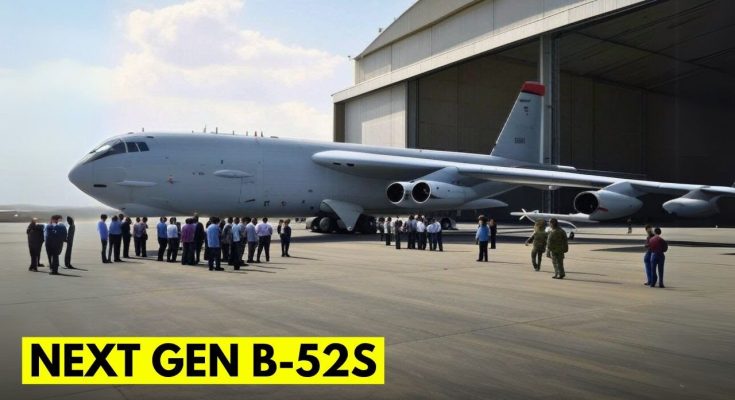The B-52 Stratofortress, a stalwart of the U.S. Air Force (USAF), has long been a symbol of military power, serving as a strategic bomber capable of carrying a wide range of conventional and nuclear weapons. Despite being in service for over 60 years, the USAF has decided to keep the B-52 flying for at least another century, pushing its operational lifespan into the 2040s or beyond. This decision may raise eyebrows, but it’s grounded in the aircraft’s unique capabilities, the evolving nature of warfare, and the high costs of replacing such a versatile platform. Here’s why the USAF is so committed to the B-52’s future and betting on it for the next 100 years.
Proven Track Record and Versatility
The B-52 was introduced in 1955, and since then, it has undergone continuous upgrades to ensure its relevance in modern warfare. This enduring design has proven itself time and again in multiple combat zones, from the Vietnam War to Desert Storm and recent operations in Afghanistan and the Middle East. Over the decades, the B-52 has demonstrated unmatched versatility in both conventional bombing missions and nuclear deterrence.
Its ability to carry a wide variety of munitions, from precision-guided bombs to nuclear payloads, and to operate in different environments—whether launching long-range strikes or providing air support in conflict zones—has kept the B-52 as a cornerstone of U.S. air power. This adaptability is one of the primary reasons the USAF continues to rely on it, even as new bombers like the B-21 Raider enter the picture.
Cost-Effectiveness
One of the most compelling reasons the USAF is opting to keep the B-52s around for another century is cost. While maintaining an older aircraft is often seen as inefficient, the B-52 has been continuously modernized, and these upgrades have made it highly cost-effective compared to the expense of developing and fielding an entirely new bomber fleet. The B-52s already have an established infrastructure and logistics network that supports their maintenance, and the cost of upgrading the airframe and avionics is far cheaper than building new bombers.
Additionally, the USAF has been making targeted investments in upgrading the B-52’s engines, avionics, and mission systems. These upgrades ensure that the aircraft remains compatible with the latest munitions and air operations technologies. The B-52’s ability to integrate new capabilities without a complete overhaul is a significant financial benefit, especially when compared to the huge developmental costs associated with new platforms.
Role in Strategic Deterrence
The B-52 plays a key role in the U.S. nuclear deterrence triad, alongside ICBMs and submarine-launched ballistic missiles. It can deliver nuclear weapons with both long-range precision and survivability. The flexibility of the B-52 to be quickly adapted for strategic deterrence, in addition to its tactical roles, ensures it is an important element in maintaining the U.S. nuclear posture. For example, it can perform nuclear signaling missions and participate in nuclear exercises with allied forces.
With the B-21 Raider still in development, the B-52’s role as a nuclear-capable platform will remain crucial for the USAF, providing an essential backup and supplement to the next-generation bombers.
Support for Future Warfare
While the B-52 is rooted in Cold War-era design, it’s evolving to meet the challenges of modern warfare, including cyber warfare, electronic warfare, and joint operations with other military branches. The latest upgrades to the B-52’s computing systems, communication gear, and weaponry ensure it remains interoperable with newer aircraft and technologies.
Moreover, the B-52’s long range and large payload capacity make it a valuable asset in future conflict scenarios that demand rapid, long-range strikes on high-value targets. The bomber’s ability to deliver a variety of payloads, from smart bombs to hypersonic weapons in the future, keeps it relevant in an evolving landscape of warfare.
The B-21 Raider and B-52: A Balanced Fleet
While the B-21 Raider will soon join the U.S. bomber fleet, the B-52’s extended service ensures the USAF has a balanced bomber force. The B-21 will provide stealth and high-end capabilities in contested environments, while the B-52 will continue to serve as a reliable, high-capacity, and versatile platform for a variety of missions. Together, these bombers will form a robust air power structure for the USAF.
Conclusion
The USAF’s decision to keep the B-52 Stratofortress flying for another century is a testament to the aircraft’s unmatched versatility, cost-effectiveness, and pivotal role in nuclear deterrence and conventional warfare. The B-52, despite its age, remains an essential element of U.S. military strategy, ensuring that it continues to adapt to the evolving demands of modern combat. As the U.S. military faces an increasingly complex global security environment, the B-52 is poised to remain a reliable and formidable part of the U.S. bomber fleet for decades to come. The commitment to extending the B-52’s service life represents a smart, pragmatic decision to maintain air superiority while also preparing for the future.



